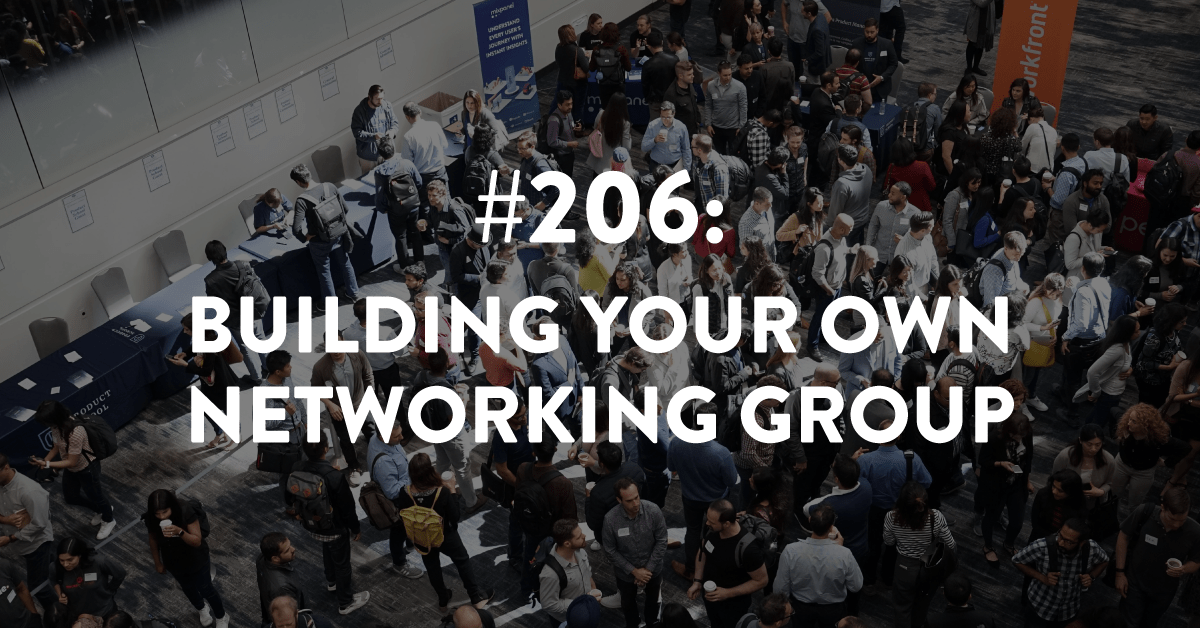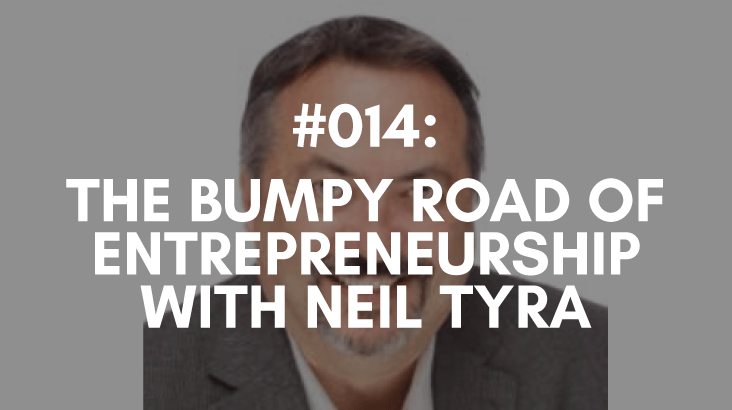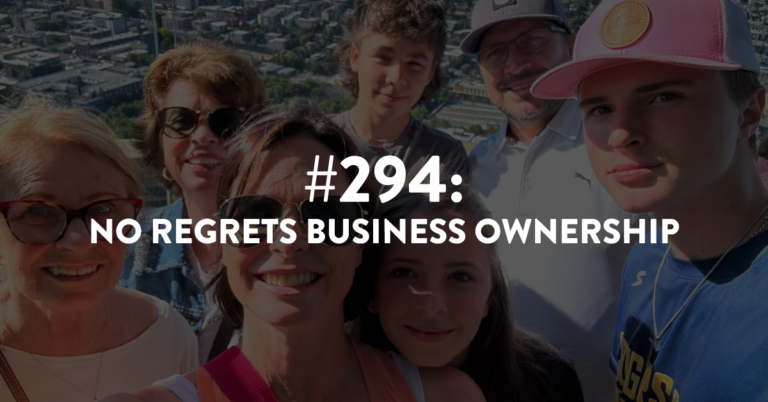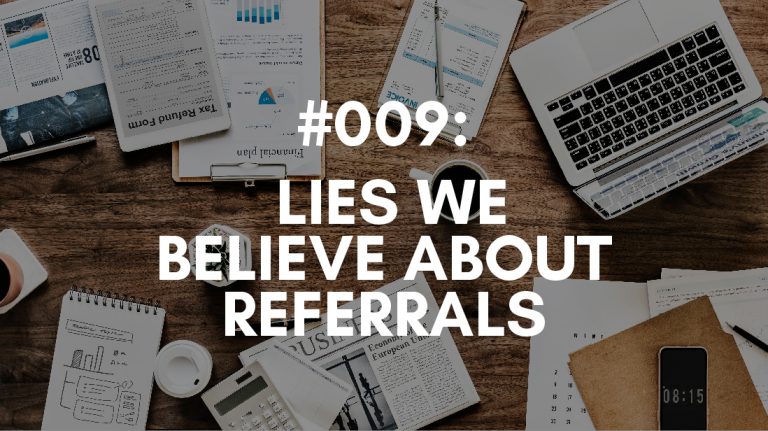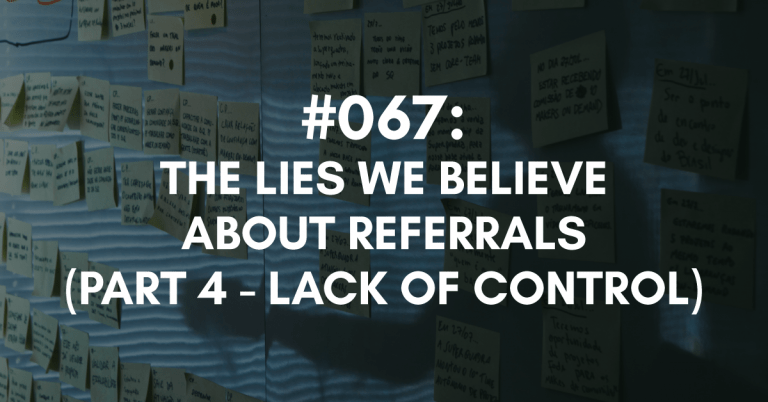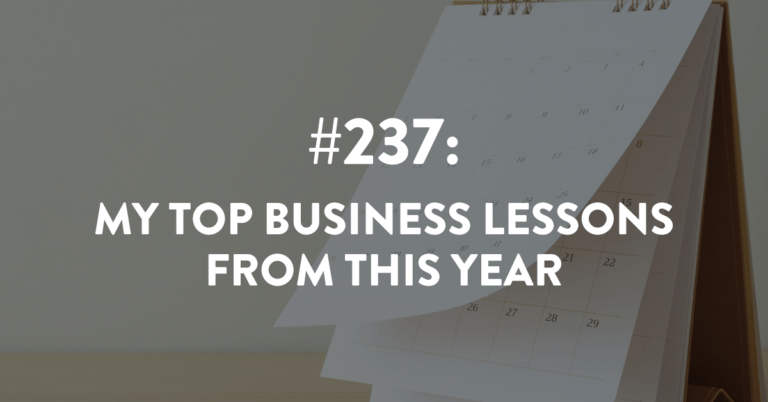Ep #206: Building Your Own Networking Group
Oh, the networking group. They can be the fishing net that feeds you—or the dreaded time drain where you question its very existence. Have you ever been in that boat? If you’ve ever thought about building your own networking group because the available networking groups in your area just aren’t working for you, then this episode is for you.
First, I am going to share the importance of taking things slowly when building your own networking group. If you walk before you can run and try to do everything at once, you are going to have massive burnout as the leader.
Next, I will explain why you have to set the group dynamic up from the beginning. Set some intentionality around who you let into the group and ensure they’re the right fit. Get to know your group, build connections, and find commonalities.
Lastly, I will describe why you can’t just focus on getting leads. Focus more on building connections rather than getting leads, and your networking group will feel far more confident and comfortable.
From the Client Shout Out:
Congrats to Erin Smith of Cultivating Connections Travel Planners on her successful first quarter in BRB (Building a Referable Business) bringing in 11 referrals and closing 82% of them!
Looking for Referral & Client Experience Resources:
Take the Referral Ninja Quiz to test your skills and abilities at generating referrals. (FREE)
Buy my book – Generating Business Referrals Without Asking – and learn how to generate referrals through my 5 steps. (LESS THAN $16)
Consider joining Building a Referable Business™ – a unique way to learn all of my referral strategies and tactics with ongoing weekly access to me to answer your questions and help hold you accountable! Email me for more details.
Coming Up:
Next episode is #207, and we discuss what referral-proofing looks like for your business.
Download The Full Episode Transcript
Read the Transcript Below:
Stacey Brown Randall: Oh, the networking group. They can be the fishing net that feeds you—or the dreaded time drain where you question its very existence. Ever been in that boat? Well, if you’ve ever thought, “Some of these networking groups aren’t working for me, I’m just going to build my own,” well, this episode has you written all over it.
You are not just another hustling salesperson. You are the expert, the
resource, the valuable partner for your clients, and how you grow your
business should reflect how your clients see you.
Welcome to the Roadmap to Grow Your Business podcast. We generate
referrals without asking, build positive client experiences, and help
you take control of your business.
Here’s your charmingly sarcastic host, Stacey Brown Randall.
Stacey Brown Randall: Hey there. Welcome to episode 206 of the Roadmap To Grow Your Business podcast. I’m your host, Stacey Brown Randall. For our shout-out this week, we have Erin Smith, CEO, travel diva, travel planner of the world with Cultivating Connections. What’s really cool about Erin’s results over the first quarter is her closing ratio. A lot of people get really focused on, how many referrals am I receiving on a monthly basis, on a quarterly basis, on a yearly basis? And it’s a good metric and it’s one I want you tracking.
And of course, if you’re in a program with me, we are absolutely tracking it because that’s how we determine the ROI of your investment and that what you’re doing is working. So while the number of referrals is super important, let’s be honest, getting a referral doesn’t actually mean that’s money in your pocket in that moment if you cannot close or convert that person to a paying client. What I’m really proud of with Erin is that the referrals that she received in first quarter, she had an 82% closing ratio.
Ultimately, I always want to see people at a 50% and above closing ratio, but my heart sings and I do a little happy dance when you’re above 75%, which means for every referral you’re receiving, you’re closing 75 or more of them into paid clients. And Erin’s doing it at 82%. Great job, Erin. Keep up the good work.
Okay, let’s dive into this episode. We’re talking about building your own networking group. I’ll be honest, when I sat down at the end of last year and planned out the editorial calendar… Throw back to my magazine days. But when I planned out the editorial calendar for this podcast… So yes, I sit down with a massive spreadsheet and I plan out what these episodes are going to be about. There is absolutely a rhyme and reason to what I do. That doesn’t mean I know all 52 weeks in January, but I certainly have a really good idea of the framework of what we’re looking at.
This topic, building your own networking group, was not anywhere on the list, not anywhere in my mind. But I had a financial advisor reach out to me who is starting a networking group. He just wanted to see if they could hire me to help them structure their networking group correctly following a lot of my philosophy that he had learned about when he read my book, Generating Business Referrals Without Asking. It was an extremely enticing proposition because I was like, “Oh, I’ve actually never done that before. That’s really cool.”
But I also knew that’s also out of my lane, that it really is out of my lane of what I do in terms of the products or services that I do and how I help my clients. And whereas it would’ve been fun to chase the bright, shiny object, I knew I would pay for it later. So I had to decline actually having them pay me to teach them or help them build out a networking group where they could actually truly generate referrals in the way that it’s supposed to be. Because ultimately, that is the goal of most groups that you join, whether you call it a leads group or a referrals group or a networking group.
One of the main objectives is to hope you’re going to get business from it and turn people in that group to become referral sources for you. It’s not the only objective. There’s definitely some groups you join because you’re there for the community and for the education, right? But some groups at some level, there is the hope that you’ll get business from them and in some cases you’ll be able to have people in that group that will refer clients to you. So it was an intriguing offer when he came to me and he said, “Hey, would you teach us how to do this?” And I had to turn them down.
But not before I gave him some advice. And basically, because I hate telling people, no, I was like, “Let’s hop on the phone and have a quick call and let me just tell you what I’m thinking. But I’m not going to take your money and I’m not going to put out expectations that I can help you further from that perspective.” And he was awesome, he was like, “I’ll take whatever time I can get.” So I did do a author Q&A with his group, so I got to see at least through virtually through Zoom some of the people that are in the group.
Because that is something if you have a group that is actually reading my book or you are part of a book club or a mastermind or something that’s actually reading my book, I do offer doing author Q&As, about 30 to 45 minutes, where I basically just show up to answer questions and make sure that you guys are getting what you need out of the book and then getting your questions answered too. It’s really fun. I’ve done a number of them this year, these little virtual author Q&A.
So if you have a group, a mastermind, a book club that is reading my book and you want me to do that for you, just shoot me an email and ask and we’ll make it happen. There are some requirements for that to actually happen for it to be complimentary, but I can walk you through all of those details. So I did do an author Q&A with this group so they could learn more about my philosophy and then I did spend some time on the phone with Jeff just walking through my thoughts on what it would look like if I were to help them build a networking group. Then of course it came down to, well, this would make an excellent podcast topic.
It is not on the agenda, it is not in the editorial calendar, let’s work some things around, let’s move some things around, and make it happen. So my friends, here we are. So here’s some of the things that I was walking through with him to understand how to build your own networking group so that it can serve a purpose of greater connection amongst the members, and also, hopefully, being able to have people in that group who will become true, actual long-term referral sources for your business.
So this isn’t everything that you would do in building a networking group, this isn’t a blueprint step by step by step by step in all 52 points, this is at a high level some of the things I told him he needed to consider and that he needed to pay attention to if he wanted to build a group that looked different from probably some of the other networking groups that were out there that he and his group found that didn’t work for him, which you would probably found some of those maybe didn’t work for you.
Maybe there were groups you’ve been in and you’ve stepped away from because either the expectations or the metrics or whatever the group dynamic was wasn’t working for you. At some point, a lot of us who have to do networking in terms of growing our business, there is that idea of finding the group that not only can feed your business, but can also feed your soul because it’s a group you have people you want to hang out with.
And I just happened to be extremely fortunate… This is years and years and years ago, more than a decade ago actually. I happened to be really fortunate to join a group where I found that, a group that I have lifelong friends out of and also got business from because some of the members became clients of mine and they’ve referred business to me as well. It was like the trifecta of perfection. But when I noticed and I looked back on what that group provided, that’s always been my benchmark for over a decade now when I help people assess networking groups from themselves.
It’s figuring out, can it measure up to the one that I was in because of how they built themselves? So here’s some of the things we talked about. These are points to consider. Number one, first and foremost, if you’re deciding to build your own networking group or starting your own networking group, please walk before you can run, because if you try to do all the things in the first year of building this amazing group, which is some of the upcoming points I’m about to make, you are going to have massive burnout as the leader.
And groups are only successful if they can survive past the founding members or past the founding person who was actually in charge of starting the group. If the group lives or breathes by you doing all the work, you are going to have burnout and your group won’t last more than a year or two. You’ve got to make sure you’ve got a structure in place and that it’s not so much your baby that you’re a control freak with it, but that you can accept help from others, and eventually other people can eventually run the group if you’ve got the right structure in place.
I know with the group that I was in, I was the president of it, but I was probably the fourth or fifth president that group had had. So anything I’m talking about, point number one is for you to always remember through anything I’m saying, walk before you run. You may have a grandiose list of things you want to accomplish, but what are the bare basics and the minimums just to get started with? Then as you add more things this group is going to do and more ways it’s going to serve and more ways it’s going to help its members and the community hopefully, that you actually have things in place so that your leader does not burn out.
Because if people only show up because that leader is telling them to show up and that’s how everything’s happening, if that leader burns out, that group is kaput, done, over with. Now, it may have been great for two years, what if it could have gone for 10? Okay, point number one, walk before you can run. Point number two, the group dynamic. The group dynamic is actually really, really important because it’s the reason you want to show up and actually network with these people. Whether that is weekly or that is monthly or that is quarterly, whether that is in person or it is online or it is a mix of both, the people matter.
That doesn’t mean you have to love everybody that’s actually in the group and feel like all of them are your new best friends, but the dynamics matter. So most groups think about the dynamics from the perspective of, we don’t want those that are in competition with each other. So we don’t want two insurance agents, we don’t want two financial advisors, we don’t want two attorneys unless they’re in an entirely different places within the law, within the legal field. So yes, it is important to look at making sure you’re not sitting in a room with like three of your other competitors because that group is not going to be very helpful for you.
But a lot of groups look at that as the one main defining marker of who gets in and who doesn’t. We can have one financial advisor, and when the spot is filled, the spot is filled. What I find with the best groups is that there’s actually an intentionality and a small group that comes together that then creates intentionality about who they will let in. And I don’t mean this from being exclusive and I don’t mean this from keeping people out, but I mean protecting the dynamic of the group of making sure that you’re letting in the people that will be great for the group and the group will be great for them as well.
So there is an idea of limiting it, but not the black and white version. I see a lot of groups is it’s just based on, hey, we got one person that’s category. When the category’s filled, we’re done. No, actually pay attention to a lot more things than just that in terms of who are their clients and who do they need? When they’re in this group, who do they need? And are those people in the room? Or at least some of those people are in the room. But how can they help others and do they have a network? All those things matter within the terms of your group dynamics.
I’m not saying this has to be point by point, you’ve got to check all the boxes. But I have found that when you’re intentional about what your group needs in it and you’re intentional in terms of making sure the group is diverse in a way that serves the benefit of everyone, the group just becomes better. So it’s not the same five or six people sitting around the room because you’re in every networking group together and so you decide to start a group with these people, it’s sometimes going outside and finding that different diversity, the different folks, but really paying attention to who needs who.
Who can actually refer to who? Or who runs in the same circles where they actually have the opportunity to connect them with other people, maybe not clients, but maybe connect them with other people that could help them find new people to grow their network or new people to be their referral sources? So whereas the group should be limited, it should also be considered based on who needs who and paying attention to the dynamic of that group more than just filling a seat.
Okay, number three. It’s really, really important that if you’re going to take the time on a weekly or quarterly or monthly basis to be in a group or to build a group that you actually get to know the people in the group. So there needs to be an importance of one-on-ones. Lots of groups have this as something they expect. We expect that you’ll do a one-on-one every month or you’ll do so many one-on-ones or we reward you with a prize if you do your one-on-ones this month. But getting to know the other person or the other people in the group is really important.
But I also find that having a structure and a framework for how those conversations could happen so that they are the most beneficial can sometimes help people feel more comfortable having those one-on-ones. And a one-on-one in this scenario is really about understanding who that person is outside of business and then who that person is within business as well. You need to get to know the person. So those one-on-ones are the best time to actually build connection and find commonalities and find things that you’re always going to remember about that other person and give you a place to really build rapport with them.
That’s only going to happen outside of group settings when you’re actually getting to know those people on a one-on-one basis. Do you need to do a one-on-one with everyone in the group in your first 30 or 60 days? No. But over time, that does need to be a part of how the group builds itself from that importance of having those one-on-ones. Okay, that was point number three. Let’s go to point number four. The idea behind your group, the objective, the goal, the mission behind your group has to be more than just lead passing. You can’t just be focused on, you’ve got to give leads or you’ve got to give referrals.
Whatever you want to call it, whether it’s right or wrong, that’s a topic for another day. But it’s got to be more than just on, hey, we show up and we pass out other people’s names that people may be able to get as clients. That shouldn’t be the main focus. It should be part of it, but not the main focus, and the group needs to be more than just lead passing focused. The groups that I have found where you want to show up, you’re invested in the other people, are the ones where you’re getting to know them outside of those weekly or monthly group sessions.
So maybe you’re actually doing volunteer work together a couple of times a year, or maybe you’re actually hosting speakers that are coming in and speaking on something happening in your local environment or maybe in your industry, if it’s not locally-based, maybe there’s something different if you’re doing it virtually and you’ve got people from all over the United States, but there’s speakers that speak that their topic would be relevant to everybody sitting there. But then when you do speaker series or you bring in speakers, it also gives you the opportunity to invite other people in so that you can grow your network.
Not growing the group, just having moments where there’s more than just the 10 or 15 or whatever it is members that you’re actually reaching out and doing something for the community from the business community perspective, or whatever that looks like for you, and then also inviting them in because that helps everyone’s network grow as well. Then of course, something else to consider is sometimes people join these groups because they’re looking for community and they’re looking for people to have thoughts and opinions on problems that they need solved.
Maybe they don’t have a business mentor or a mastermind group or something else like that they go to, or a business coach or someone they ask. So these networking groups become an opportunity for them to share what they’re dealing with in their business as much as they’re comfortable sharing and the stuff that they… as long as it’s like a cone of silence and it’s the safety net, everything said in here is safe. But having member-focused time is also important.
Whether you call them hot seats or you’re teaching the other members of the group something about what you do that they all could use, or hot seats where you’ve got a problem, you define the problem, and then everybody can ask questions but they can’t give you advice, I think that’s a model that a lot of other groups use. I know EO uses that group within their EO forms where it’s more question-based. It has a name, I don’t remember it. But it’s question-based where, “Hey, here’s my problem,” and the members can only ask questions, and in answering the questions, that helps create possibly some options for the member who is in the hot seat.
But just some different things you can consider doing. My point is, in talking about doing member-focused time, and then of course volunteering or speaker series or different things like that, is be more than just lead passing. Then of course the fifth point is, please, please take a minute and teach proper referrals. This may be very personalized to my world, but passing someone’s name off who has no idea that you’re passing their name off, that is called a lead, not a referral. So let’s make sure your group involves like, “Hey, this is what a referral looks like. This is the way that we give referrals.”
There’s a personal connection and a need identified in the prospect and there’s a reason why I’m connecting you to them. And that is really important, so don’t overlook that. All right. So in recap, here are the five points to consider. One, walk before you run. Two, consider the group dynamics. Three, focus on the importance of your one-on-ones. Four, be more than just lead passing focused. And five, please teach how to provide proper referrals. Okay, we’ll talk about this and of course have the transcripts for this episode on the show notes page at staceybrownrandall.com/206. That’s for episode 206.
And if you’re curious, of course, my book, Generating Business Referrals Without Asking, is available wherever books are sold. And this group that came to me with this question, that is the reason why we had this whole episode on this, is because they actually read through the book and they were taking that philosophy that I talk about and then I teach in the book to build out a networking group. And you can do the same thing by reading that book as well and then using the points that we talked about in this episode if you are interested in building out a networking group.
They’re not for the faint of heart. I’m not recommending you do them if you don’t need them. I’m just saying, if you’ve ever thought about doing them, it could be one for you to consider. Okay, coming up next week is episode 207. We’re going to talk about what referral-proofing your business looks like. Until then, you know what to do my friends. Take control and grow your business. Bye for now.
Thanks for listening to the Roadmap to Grow Your Business podcast. To
access all resources and links mentioned in today’s show, and to
connect with Stacey, head over to www.staceybrownrandall.com.

